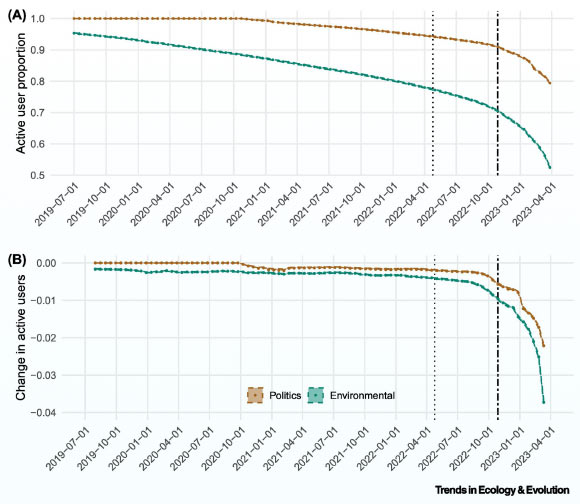In a study sample of 380,000 environmentally oriented users, nearly 47.5% became inactive on Twitter (recently renamed X) after it was sold in October 2022. Given Twitter’s importance for public communication, the findings have troubling implications for digital environmental information sharing and public mobilization.

Tracking changes among Environmental and Politics Twitter users: (A) the proportion of users that were active in each 15-day window; (B) the rate of change in the proportion of active users for both samples. In both plots, the points depict the observed data while the color band with a broken line shows the 99% confidence interval based on a bootstrap sample of the data. The broken vertical line corresponds to April 25, 2022, when the Twitter board accepted Musk’s initial purchase offer, and the heavier broken line corresponds to October 28, 2022, when Musk’s takeover was finalized. Image credit: Chang et al., doi: 10.1016/j.tree.2023.07.002.
Since Elon Musk’s acquisition of Twitter, researchers and industry scientists have raised alarms about the platform’s integrity.
Days after the acquisition was finalized on October 28, 2022, industry analysts reported that over one million users were no longer active on the platform, a doubling of the previous baseline.
Rising abuse and hate speech on the platform due to Musk’s decision to change content moderation could have driven this change.
Recent findings suggest that hate speech increased substantially after the Twitter sale and that engagement increased much more markedly for contentious right-wing actors than a comparison sample.
Changes to the application programming interface and service outages have impeded volunteer and researcher access to real-time Twitter data with real-world consequences. For instance, these changes posed major hurdles to crowd-sourcing information during the recent earthquake in Turkey and Syria.
The platform’s modified governance resulted in overdue payments to cloud services vendors such as Google Cloud, accompanied by throttling user access to posts, negatively impacting user experience and information sharing.
Changes since Twitter’s acquisition likely have ripple effects for other user segments, such as the climate policy sphere, or future disaster response after extreme weather events.
“Twitter has been the dominant social media platform for diverse environmental interests to communicate and organize around advocacy goals, exchange ideas and research, and new opportunities for collaboration,” said Pomona College researcher Charlotte Chang and colleagues.
“As a result, Twitter has been used to track a broad array of topics important to conservation and environmental research, ranging from biodiversity conservation, human-nature interactions, climate change beliefs, extreme weather disaster responses, and environmental policy preferences, as well as to disseminate information and mobilize public interest by environmental non-governmental organizations (NGOs) and public agencies.”
In their study, the researchers studied a group of 380,000 environmental supporters, a group that frequently discussed climate change mitigation and biodiversity conservation.
Users were considered ‘active’ if they posted on the platform at least once within a 15-day period.
The scientists found that in the 6-month period after Musk took over Twitter, only 52.5% of these environmental users were still actively using Twitter — a substantially larger drop-off rate than other ‘comparable online communities,’ including users who discuss general politics on the platform.
“There is currently no platform equivalent to Twitter,” they said.
“Thus, any changes in engagement by environmentally-minded users raise serious questions about where to track discourse about environmental conservation and how to mobilize pro-environmental segments of the public.”
Going forward, the authors call upon scientists to take an active role in the transition towards different modes of environmental communication — whether that be advocating for change within Twitter to help make it a useful platform for environmentalists again or collectively switching to another platform like Mastodon or Threads.
They also point to resources like the Coalition for Independent Technology Research, which bring people together to voice concerns to Twitter representatives and policymakers.
“The future of Twitter as a platform for outreach and research is uncertain,” they said.
“We need to create collaborations across industry, the non-profit sector, and academia to track public engagement with the environment across social media platforms for the benefit of primary research, applied environmental conservation, and climate mitigation.”
The findings were published in the journal Trends in Ecology and Evolution.
_____
Charlotte H. Chang et al. Environmental users abandoned Twitter after Musk takover. Trends in Ecology and Evolution, published online August 15, 2023; doi: 10.1016/j.tree.2023.07.002







